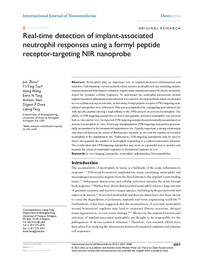
ATTENTION: The works hosted here are being migrated to a new repository that will consolidate resources, improve discoverability, and better show UTA's research impact on the global community. We will update authors as the migration progresses. Please see MavMatrix for more information.
Show simple item record
| dc.contributor.author | Zhou, Jun | |
| dc.contributor.author | Yi-Ting, Tsai | |
| dc.contributor.author | Weng, Hong | |
| dc.contributor.author | Tang, Ewin N. | |
| dc.contributor.author | Nair, Ashwin | |
| dc.contributor.author | Digant, Dave P. | |
| dc.contributor.author | Tang, Liping | |
| dc.date.accessioned | 2014-08-13T15:31:35Z | |
| dc.date.available | 2014-08-13T15:31:35Z | |
| dc.date.issued | 2012-04-19 | |
| dc.identifier.citation | Published in International Journal of Nanomedicine 7:2057–2068,2012 | en_US |
| dc.identifier.issn | ISSN: 1176-9114 | |
| dc.identifier.issn | ESSN: 1178-2013 | |
| dc.identifier.uri | http://hdl.handle.net/10106/24540 | |
| dc.description.abstract | Neutrophils play an important role in implant-mediated inflammation and
infection. Unfortunately, current methods which monitor neutrophil activity, including enzyme
measurements and histological evaluation, require many animals and cannot be used to accurately
depict the dynamic cellular responses. To understand the neutrophil interactions around
implant-mediated inflammation and infection it is critical to develop methods which can monitor
in vivo cellular activity in real time. In this study, formyl peptide receptor (FPR)-targeting nearinfrared nanoprobes were fabricated. This was accomplished by conjugating near-infrared dye
with specific peptides having a high affinity to the FPRs present on activated neutrophils. The
ability of FPR-targeting nanoprobes to detect and quantify activated neutrophils was assessed
both in vitro and in vivo. As expected, FPR-targeting nanoprobes preferentially accumulated on
activated neutrophils in vitro. Following transplantation, FPR-targeting nanoprobes preferentially accumulated at the biomaterial implantation site. Equally important, a strong relationship
was observed between the extent of fluorescence intensity in vivo and the number of recruited
neutrophils at the implantation site. Furthermore, FPR-targeting nanoprobes may be used to
detect and quantify the number of neutrophils responding to a catheter-associated infection.
The results show that FPR-targeting nanoprobes may serve as a powerful tool to monitor and
measure the extent of neutrophil responses to biomaterial implants in vivo. | |
| dc.language.iso | en_US | en_US |
| dc.publisher | Dove press | en_US |
| dc.subject | In vivo imaging | en_US |
| dc.subject | Nanoprobe | en_US |
| dc.subject | Neutrophils | en_US |
| dc.subject | Inflammation | en_US |
| dc.subject | Biocompatibility | en_US |
| dc.title | Real-time detection of implant-associated neutrophil responses using a formyl peptide
receptor-targeting NIR nanoprobe | en_US |
| dc.type | Article | en_US |
| dc.publisher.department | Department of Bioengineering, The University of Texas at Arlington | en_US |
| dc.identifier.externalLinkDescription | The original publication is available at the Article DOI | en_US |
| dc.identifier.doi | http://dx.doi.org/10.2147/IJN.S29961 | |
Files in this item
- Name:
- Nair-real-time-detection-of-im ...
- Size:
- 2.524Mb
- Format:
- PDF
- Description:
- PDF
This item appears in the following Collection(s)
Show simple item record


